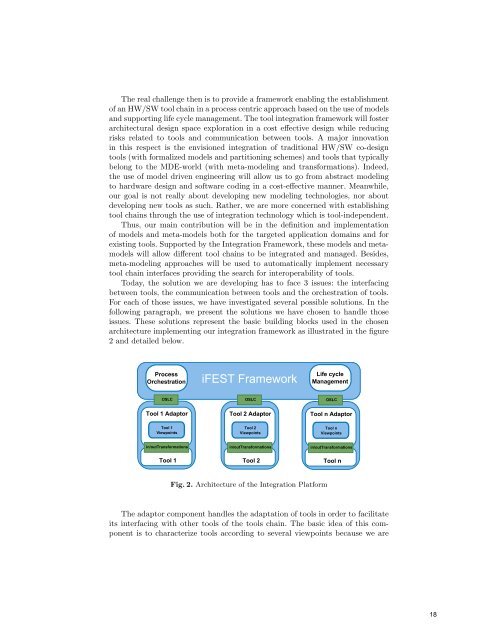A Framework for Integrating ESL Tools - IRIT
A Framework for Integrating ESL Tools - IRIT
A Framework for Integrating ESL Tools - IRIT
Create successful ePaper yourself
Turn your PDF publications into a flip-book with our unique Google optimized e-Paper software.
The real challenge then is to provide a framework enabling the establishment<br />
of an HW/SW tool chain in a process centric approach based on the use of models<br />
and supporting life cycle management. The tool integration framework will foster<br />
architectural design space exploration in a cost effective design while reducing<br />
risks related to tools and communication between tools. A major innovation<br />
in this respect is the envisioned integration of traditional HW/SW co-design<br />
tools (with <strong>for</strong>malized models and partitioning schemes) and tools that typically<br />
belong to the MDE-world (with meta-modeling and trans<strong>for</strong>mations). Indeed,<br />
the use of model driven engineering will allow us to go from abstract modeling<br />
to hardware design and software coding in a cost-effective manner. Meanwhile,<br />
our goal is not really about developing new modeling technologies, nor about<br />
developing new tools as such. Rather, we are more concerned with establishing<br />
tool chains through the use of integration technology which is tool-independent.<br />
Thus, our main contribution will be in the definition and implementation<br />
of models and meta-models both <strong>for</strong> the targeted application domains and <strong>for</strong><br />
existing tools. Supported by the Integration <strong>Framework</strong>, these models and metamodels<br />
will allow different tool chains to be integrated and managed. Besides,<br />
meta-modeling approaches will be used to automatically implement necessary<br />
tool chain interfaces providing the search <strong>for</strong> interoperability of tools.<br />
Today, the solution we are developing has to face 3 issues: the interfacing<br />
between tools, the communication between tools and the orchestration of tools.<br />
For each of those issues, we have investigated several possible solutions. In the<br />
following paragraph, we present the solutions we have chosen to handle those<br />
issues. These solutions represent the basic building blocks used in the chosen<br />
architecture implementing our integration framework as illustrated in the figure<br />
2 and detailed below.<br />
Process<br />
Orchestration<br />
iFEST <strong>Framework</strong><br />
Life cycle<br />
Management<br />
OSLC<br />
OSLC<br />
OSLC<br />
Tool 1 Adaptor<br />
Tool 2 Adaptor<br />
Tool n Adaptor<br />
Tool 1<br />
Viewpoints<br />
Tool 2<br />
Viewpoints<br />
Tool n<br />
Viewpoints<br />
in/outTrans<strong>for</strong>mations<br />
Tool 1<br />
in/outTrans<strong>for</strong>mations<br />
Tool 2<br />
in/outTrans<strong>for</strong>mations<br />
Tool n<br />
Fig. 2. Architecture of the Integration Plat<strong>for</strong>m<br />
The adaptor component handles the adaptation of tools in order to facilitate<br />
its interfacing with other tools of the tools chain. The basic idea of this component<br />
is to characterize tools according to several viewpoints because we are<br />
18

















